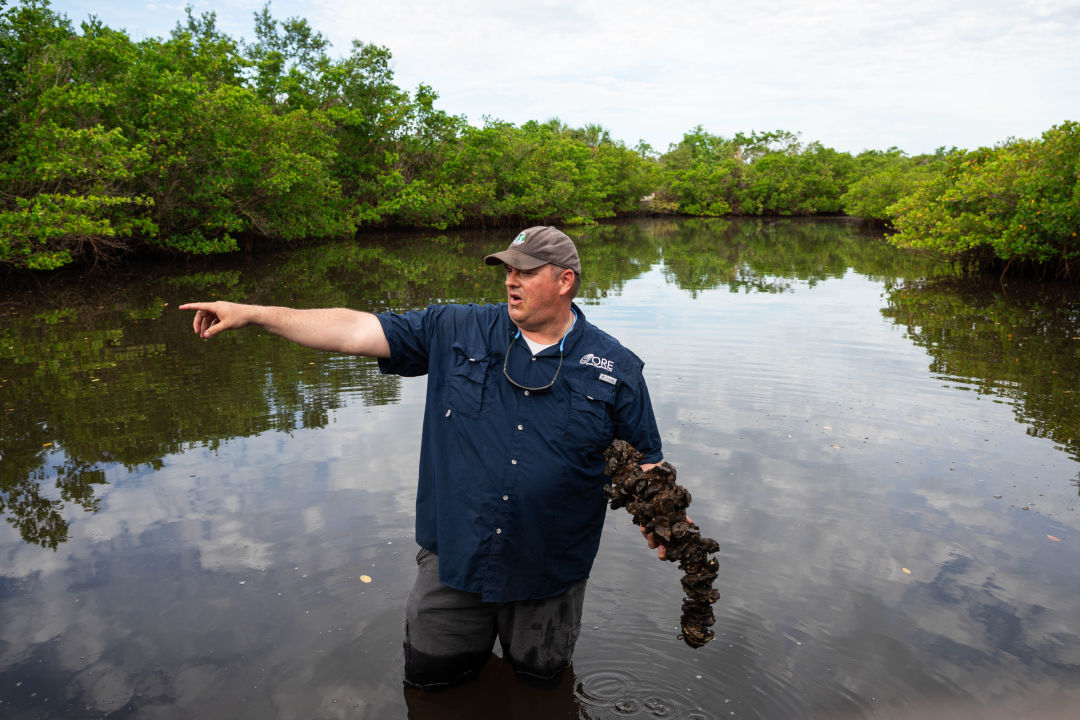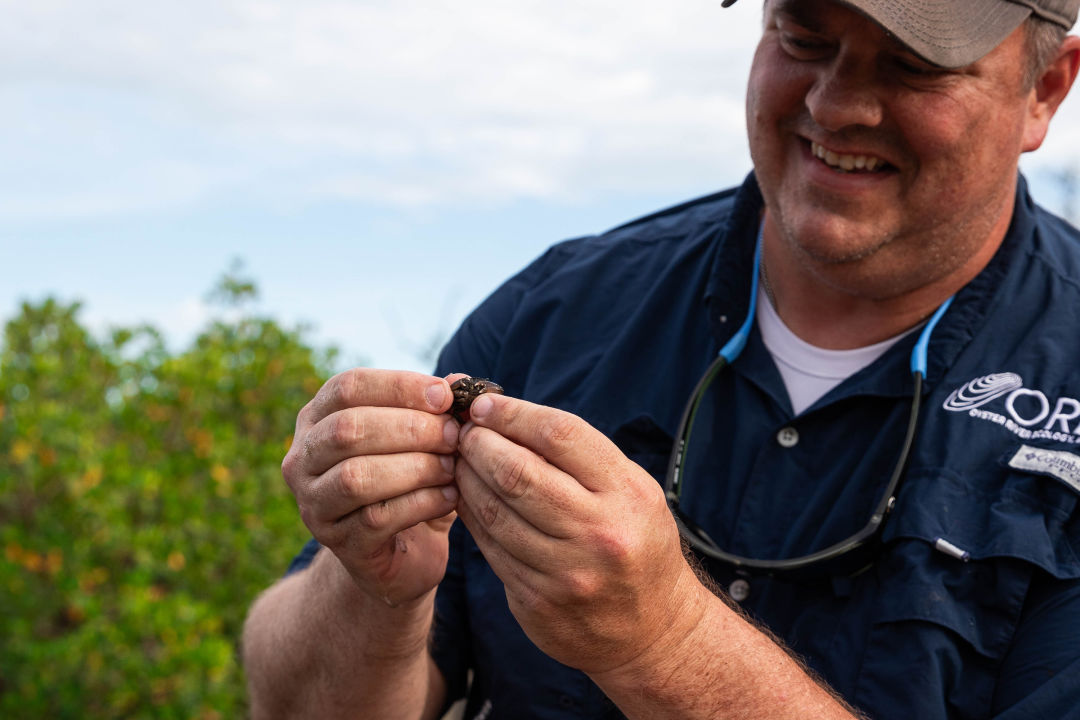A New Nonprofit Wants to Rehabilitate Hundreds of Acres of Local Oyster Habitat

Damon Moore, the founder and executive director of Oyster River Ecology
Image: Hannah Phillips
At some point, everyone who loves our natural world experiences a punch-in-the-stomach realization at just how much environmental damage humans have caused. For Damon Moore, that moment came during the 2018 red tide bloom that engulfed Florida’s west coast. The effects were devastating: More than 2,400 tons of dead marine life was cleaned from beaches and bay waters, and the state lost nearly $200 million, according to researchers at the University of Florida. It was one of the longest and most severe red tide events in recent memory.
At the time, Moore was working in Manatee County’s parks and natural resources department. He watched a video showing aerial views of places he'd fished with his father, Dave, as a kid. The area was dotted with dead fish.
“That hit me in the stomach,” Moore told me last month via Zoom. “I know some habitats repair themselves, but that level of destruction for our natural systems—and for fishing, such an important part of our economy—made me really sad.”
It also drove Moore to commit to making a difference. Among his fondest childhood memories were family trips to local preserves, which made him fall in love with Southwest Florida’s beauty, from its native plants to its mangroves and wetlands. Moore developed a burning desire to protect it.
Today, Moore, 44, runs Oyster River Ecology, a new nonprofit centered on large-scale habitat restoration projects. So far, they include hundreds of acres of oyster restoration, water-quality improvement projects, trailhead enhancements at Perico Reserve in Bradenton and an educational project for the Palmetto Boys & Girls Club. Early grant support has come from the Charles & Margery Barancik Foundation, but, for now, it’s a one-man operation: just Moore, who has 20 years of habitat restoration experience. (The nonprofit also has a six-person volunteer board.)
“Anything I can do in my power to improve the fisheries and water quality, I’m pushing hard to do it,” Moore told me during our interview. “We’re not aiming small. This is the kind of work I was put on Earth to do.”
This interview has been edited for length and clarity.

Damon Moore
Image: Hannah Phillips
How did the idea for this organization emerge?
"This has been in the back of my head for over a decade. I felt the community needed to facilitate more environmental projects. There’s some great habitat restoration in our area. The estuary programs and the county and water management are doing great things, but I wanted to get more of that done because now, more than ever, habitat restoration is needed everywhere. When you drive around here, you see more destruction."
What kinds of projects will you focus on?
"I’ve done a lot of habitat restoration. We’ve already gotten a couple of grant awards. We’re working with Manatee County to go after oyster habitat restoration, which is exciting. The Palmetto Boys & Girls Club director told me he’d heard me present and said he wants to expose his kids to pollinator gardens and teach them about native plants and animals. It’s about getting out in nature and improving the natural world.
"It resonates with me. I was in middle school when I got involved in the environment. It’s special when you can come to a place years later and see the trees you planted maturing, birds showing up that didn’t used to be there, and fish using areas they previously didn't. That’s what drives me."
What distinguishes your organization from other environmental groups?
"One thing that will distinguish us is the scale of the restoration projects we’re after. My background is in large-scale coastal habitat restoration. I want to leverage that expertise with my network. We intend to do big, impactful projects. Probably the biggest one we’re working on right now is the habitat oyster restoration in the Manatee River. We’re talking about hundreds of acres of oyster restoration. Volunteers are critical to raising awareness. We want big federal grants for our projects so there’s a benefit for generations from a habitat perspective, water quality perspective and community heritage perspective because this is part of our history."
Why such a focus on oysters?
"Oysters are a primary focus area because they’re crucial to water health. The animals filter and clean water, attract fish, serve as barriers to storms and tides, and provide food. We want to bring more to the Manatee River."
What other shifts have you noticed?
"A constant flood of people has been moving here because it’s paradise. But the downside is that it’s hard to keep things looking how they did 10 years ago or 50 years ago. Two hundred years ago, there were massive oyster fisheries here. When I present restoration projects, I always dig into that history to fully understand what we’re trying to restore and why.
"Sometimes that brings in stakeholders who wouldn’t normally be interested in restoration projects. But the historical perspective is something they grasp and appreciate."
How would you characterize the environmental damage you’ve seen in our area?
"I have what I saw and then what I call 'Big Dave stories.' Big Dave is my dad. He grew up in the area. He fished in Sarasota Bay. In the 1990s, as a kid, I fished with him, and he would say, 'We catch a lot more than we used to. Things can get better.' So I grew up with the concept that things are reversible. In high school, I was lucky. I had a good teacher that led a wetland restoration project. It was very hands-on.
"In college, I got into plant ecology and freshwater wetland systems. When you learn the ins and outs of plants, you see problems other people don’t. Once, I did environmental permitting in what’s all Lakewood Ranch now. It was all agricultural then, but still had functioning wetlands with decently high-quality systems. I saw how when you affect the building blocks, those lower trophic levels, the plant life, you’re affecting everything, including the birds. Every other part of nature starts to go away. When you drive out there now, it’s all houses."
When did you fall in love with the natural world? Was it while fishing with your dad?
"It goes beyond fishing. I was lucky to have parents who took us to nature preserves all the time. They also gave us a long leash. We were probably some of the most feral children in the area. We got out and experienced wooded areas. It wasn’t forests. It was undeveloped lots that are neighborhoods now.
"I got to appreciate nature and feel that sense of wonderment that makes you feel small. I grew up in the Whitfield area, near the airport. Out of school, I worked at an environmental consulting firm. I learned quickly that we need to expose kids to recognize what a truly special place this is.
"I’ve given tours of Duette Preserve. I’ll pick a meter of pine flatwoods in good condition and say, 'What’s in that square meter?' And I’ll point out 30 plants and talk about the relationships those plants have with the fungus that’s growing. You can show people how Florida is awesome like that. I also remind them that these natural areas can’t be disturbed.
"We have so much biodiversity in the area. That makes our area special, so we’re trying to restore that and show people why it matters."
How can people get involved?
"Like us on Facebook. I put most of our updates there. We’ll have volunteer opportunities soon."
What are your favorite natural areas near home?
"I have a water answer and a land answer. On the water, it’s the Manatee River, learning every nook and cranny of that thing. I do that on my days off, too. On land, it’s the Duette Preserve. That’s about 30,000 acres of well-managed, nearly pristine habitat, embodying what natural Florida is. I get goosebumps thinking about it. It’s such an awesome place. I go out there in the heat and look for rare plants. That’s what I do in my spare time."
What can people do to help in the fight for our natural resources?
"Be aware of what’s going on here and get involved. That can be everything from how you vote to the choices you make as a consumer—even something as simple as going to a native plant nursery and getting a pot of native plants to put on your front porch. As long as it’s not screened in, you will benefit native wildlife. I always give that to people as gifts.
"No action’s too small. But we need to aim big."



